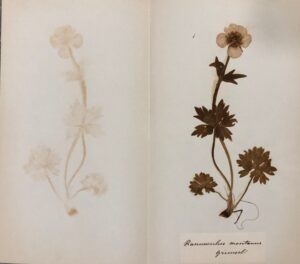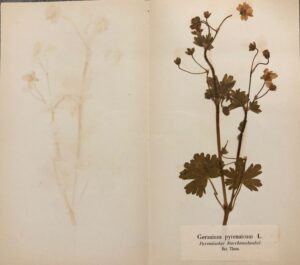From its earliest days, St. Paul’s School has emphasized the importance of the natural world in a well-rounded education. Not only did founder Dr. George Cheyne Shattuck, Jr. choose Millville because he had a “country home in a healthy and beautiful spot”, but also because he firmly believed that “[g]reen fields and trees, streams and ponds, beautiful scenery, flowers and minerals are educators.”

He was right. With the entire neighborhood countryside to explore, students spent their free time outdoors collecting flowers, rocks, minerals, and animal sightings. Before long, they began organizing themselves into clubs and societies. The Botany Club began in February 1881. At the first meeting, they created By-Laws which set their membership at twenty students and set the parameters for plant collection. Some early rules included:
VII. All flowers must be picked and pressed by the person who hands them in.
VIII. Collectors may have assistance in mounting and classification but they are recommended to classify them themselves.
XIII. No flowers which are collected in other locations can be handed in for the prize.
XIV. No cultivated flowers can be handed in for the prize.
XVI. The standard of classification shall be Gray’s Manual, edition 1880.
“We are glad to make special mention of the new Association which has sprung into existence in our midst, and which bids fair to be a lasting and potent factor in the life of the School. We refer to the Botany Club, which originating in the “Flower Committee” of the Guild, now has a separate organization, with a constitution of its own.” (Horae Scholasticae, 4 April 1881)
The Mineral Society started around the same time. “We must not neglect to mention the Mineral Society, which, with the return of spring, we hear is bestirring itself once more….They have a small laboratory in the Miller’s House, and besides possessing a collection of minerals, are organizing a small private library. Mr. J.M. Coit meets them once a week in a class in Geology, and they hope, in the early summer, to go on geologizing trips around the neighborhood.” (Horae Scholasticae, 4 April 1881)

Within two years, these two groups decided to merge and create “one permanent and well-established association”. They argued that “such an organization would be of great help in bringing before the boys that large part of science, which must be learned outside of the school-room, and that, so far from smothering the two recognized branches of Natural History, it would only widen their bounds so as to allow them a more extended growth.” (Horae Scholasticae, 22 February 1883)
The Scientific Association would be the main science club for the school through the late 1960’s. Meetings included paper presentations describing or explaining scientific subjects; guest lectures and “pleasant talks from gentleman of scientific distinction”; and informal discussions on more familiar scientific topics. The Scientific Association was also responsible for an annual exhibit held during the Thanksgiving holidays. The Botany Club and Mineral Society would continue as committees within the larger Association.
While the Scientific Association no longer exists at SPS, its echoes can be seen in the various science clubs of today like GAINS (Girls Advancing In STEM), the Robotics club, Physics=Phun, the computer science club, and more.
Cover photo- Pressed Flowers of the SPS Botany Club: Gentiana acaulis L. (Trumpet gentian)
Leave a Reply